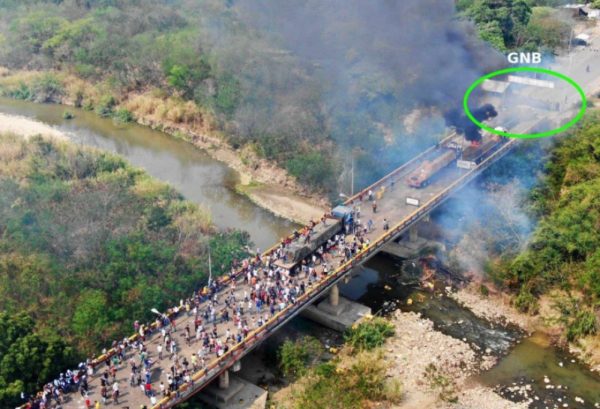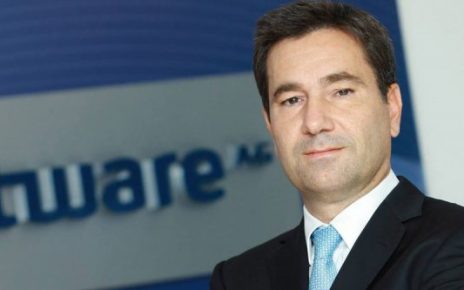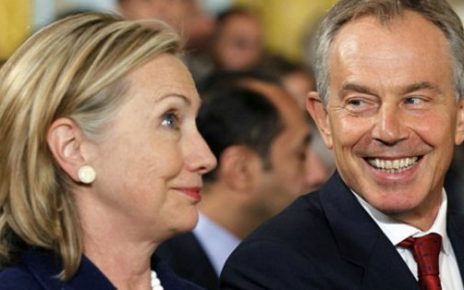February 23 saw the latest attempt by the White House, its right-wing regional allies, and self-proclaimed “Interim President” Juan Guaido to oust the Venezuelan government of Nicolas Maduro, this time by trying to undermine Maduro’s authority and forcibly violate Venezuela’s borders under the pretext of bringing in “humanitarian aid.”
Given that not a single truck, boat or plane entered the country, and that Venezuela’s armed forces remained steadfast in their defence of the national sovereignty, it can be said that Trump’s and Guaido’s primary objectives were a failure.
They did, however, achieve some level of success in their secondary goal of further satanizing Maduro in the eyes of the world.
By provoking a series of violent confrontations along the Colombian and Brazilian borders, the Trump-backed opposition has managed to manufacture a false narrative designed to delegitimize the Maduro government and justify further foreign military intervention. This narrative has been uncritically disseminated by the international corporate media. In what follows, we debunk four lies repeated ad nauseam by the mainstream press.
1. Who burnt the aid trucks?
One of the oft-repeated lies is that Maduro ordered the burning of two large aid-laden trucks attempting to cross the bridge which connects Venezuela and Colombia in Ureña.
Mainstream media latched on to the story, stating as fact that “Two [trucks] were burnt to a cinder and two were stolen by Mr Maduro’s forces,” as The Telegraph reports.

The context here is crucial: as the images show, the trucks burst into fire some 50 metres away from the piquet of the Venezuelan Bolivarian National Guard (GNB) and Bolivarian National Police (PNB).
According to testimonies of the right-wing protestors as well as Colombian policemen on the other side of the bridge, the GNB and PNB used tear gas and rubber bullets, neither of which are flammable nor capable of penetrating the gas tank of a large truck. No live rounds, grenades, or flamethrowers were used by Venezuelan state security personnel. As such, the claim that the GNB or PNB set the trucks on fire is hard to fathom.
By contrast, the opposition activists were seen hurling Molotov cocktails, while standing only metres from the trucks. These reports were confirmed by on-the-spot journalists, including teleSUR reporter Madelein Garcia and others.
Moreover, Garcia reported that it was the very same opposition militants who set fire to the truck, publishing photos that appear to show demonstrators pouring gasoline on the vehicles.
1. #ÚltimoMinuto| en #exclusiva @teleSURtv aquí las evidencias de quienes quemaron el camión con supuesta ayuda humanitaria en #Ureña, fueron los mismo guarimberos pic.twitter.com/4gv2K54NpE
— Madelein Garcia (@madeleintlSUR) February 23, 2019
“Here is the evidence that those who burnt the truck with the supposed humanitarian aid in Urena were the same guarimberos [violent protesters].”
Venezuelan Communications Minister Jorge Rodriguez, for his part, has alleged that the protesters were paid to set the trucks on fire, pointing to a video of a scuffle between opposition supporters and Venezuelan National Assembly Deputy Jose Manuel Olivares who was in charge of the “aid” operation on the Venezuela-Colombia border. Rodriguez claims the fight was sparked by a payment dispute, but did not offer further evidence to support his claim. Venezuelan media outlet Lechuguinos also interviewed unnamed sources allegedly involved in the protests who claim to have been promised up to US $4,000 for torching the truck.
While it remains impossible to determine with absolute certainty the cause of the burned trucks or the potential malintent behind it, all reports and basic logic contradict the generalised conclusion that the responsibility belongs to the Maduro administration. Likewise, we must ask the perennial question, cui bono? The answer is unambiguous: Trump, Guaido, and all those forces seeking to rationalize the violent ouster of Maduro by presenting him as a bloodthirsty dictator who is keeping desperately needed aid from his own people.
2. Is the Maduro government really blocking international humanitarian assistance?
Another of the great mistruths circulating in international media is that the Bolivarian government is blocking all international efforts to supply vital food and medicine, while The Guardian claims, “Hungry Venezuelans living nearby are wondering when they will next eat.”
The truth, rather, is that Caracas has requested and is currently receiving international humanitarian assistance, especially from multilateral bodies like the International Red Cross (IRC), the United Nations (UN) and regional healthcare organisations. The government has only blocked what these same humanitarian bodies have criticized as “politicised” aid coming from the US State Department’s notorious USAID branch, which looks to instrumentalize aid as a tool of regime change.
Only 48 hours before the February 23 border showdown, Maduro announced that his government is coordinating US $2 billion worth of “technical” humanitarian assistance with the UN and the EU-led International Contact Group. This is close to 20 times what the US and its allies have pledged to Venezuela. While the Contact Group is yet to issue a formal comment, a statement from the EU some days later confirmed that the body has provided more than €60 million in 2018 and 2019 in international assistance to the country through official government channels.
As part of this aid, it was reported that Venezuelan authorities supplied the UN/EU with a list of medicines which they have been unable to purchase in the international market largely as a result of US-led financial sanctions. They are requesting international assistance in purchasing these goods, offering to pay for them in full.
Speaking to a host of followers at the end of a rally in Caracas Saturday, Maduro committed his government to buying all food products which Brazil is willing to sell to them, and announced that a 7.5 tonne shipment of medicines from Russia arrived in the Caribbean nation over the weekend in coordination with the Pan-American Health Organisation.
The corporate mainstream media has conveniently ignored the pointed criticisms voiced by the UN, IRC, and over 70 Venezuelan and international humanitarian organizations over Washington’s “politicization” of aid efforts. Nor have international outlets reported that both the UN and IRC have recently announced that they will be increasing long-existing aid initiatives in the country in coordination with the Maduro administration.
3. How many soldiers deserted?
If all the above wasn’t bad enough, the international media is regurgitating unsubstantiated claims from the US government, Colombian authorities, and the Organisation of American States (OAS) that more than 100 Venezuelan soldiers deserted on February 23, a figure which Mike Pence elevated to 200 on Monday. Colombian authorities further increased their official count to over 300 on Tuesday. To date, no clear evidence for these claims has been provided, and given the political interests of the players, they should elicit skepticism.
The alleged figures have been repeated by the mainstream press, with one recent report from BBC correspondent Orla Guerin mentioning over 100 desertions but publishing a photo with only seven soldiers. A video showing Guaido addressing soldiers in Colombia was released Sunday, but the numbers do not appear to match the desertions claimed.
The most famous “desertion” took place in the early hours of February 23 when three Venezuelan national guardsmen drove a pair of armoured cars across the Simon Bolivar bridge and handed themselves over to Colombian authorities. Prior to surrendering to Colombian forces, the rogue guardsmen had rammed their vehicles into the barrier on the Venezuelan side of the bridge, injuring a police officer and a Chilean photojournalist in what eyewitnesses reported as a deliberate effort to injure bystanders.
Further on-the-spot video footage also shows Venezuelan opposition activists on the Colombian side telling local police that the alleged deserters are “Ours, [they are] with us!” hinting that it may have been a pre-planned “desertion.”
While no exact numbers exist of soldiers who left their posts on Saturday, the claims being circulated by the mainstream media so far have not been backed by photographic or video evidence, or on-the-ground reports.
4. Did the aid contain medicine?
Another canard reproduced by the international media is the notion that Washington’s aid shipment contained, in addition to food, essential medicines for sick Venezuelans condemned to die by Maduro.
“Almost 200 tonnes of aid in a convoy of trucks has been waiting to cross several border bridges – including food and medicine – and the tear gas was fired as protesters tried to stop the aid from being destroyed,” Sky News reports.
However, this assertion has been called into question since Saturday. According to New York Times reporter Anatoly Kurmanaev, the trucks that the opposition tried to force across the border contained “no medicine” at all, with reports that a “small” amount of medicine was being stockpiled in Cucuta not confirmed by USAID. Initial inventories from USAID made no mention of medicine, listing only basic food and personal hygiene products amongst the “aid”.
Sources: www.theantimedia.com, www.venezuelanalysis.com



